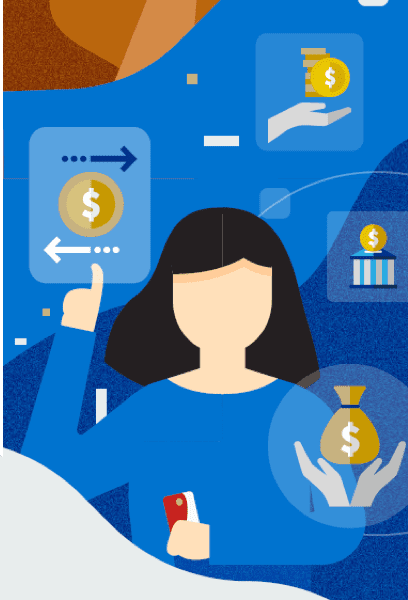By Sophie Theis, Giudy Rusconi, Elwyn Panggabean, Sonja Kelly
Women’s World Banking’s research shows government-to-person payments, if well-designed, hold potential for women’s economic empowerment and inclusion in Indonesia. With Covid-19, the stakes are even higher.

Yet as described in Women’s World Banking’s new publication, Delivering on the potential of digitized G2P: Driving women’s financial inclusion and empowerment through Indonesia’s Program Keluarga Harapan, these G2P programs have not yet achieved active account use—a major barrier to progress on women’s financial sector engagement and economic empowerment.
To study the potential of G2P for women’s economic empowerment in Indonesia, Women’s World Banking conducted large-scale mixed methods research with recipients of Program Keluarga Harapan (PKH), Indonesia’s largest cash transfer program. In 2017, PKH shifted its payment channels from cash to bank accounts for its nearly 10 million beneficiaries. For most recipients, the basic savings account (BSA) was their first owned product with a formal financial services provider (FSP).
We were drawn to study PKH because in many ways, PKH has the right conditions in place to support recipients’ engagement in the formal financial sector. The BSA can be used for savings, person-to-person transfers, and payments at low or no fees. Plus last-mile financial infrastructure to access accounts, including branchless banking and ATM networks, is relatively strong.
Deploying a nearly 2,000-person survey and robust qualitative research in ten provinces of Indonesia, we focused our research on what factors influence recipients’ use of accounts. Our research shows that most recipients (79.3% of respondents) currently only use the account for cashing out their benefit. Another 11.6% would cash out fully if they understood there is no minimum balance requirement.
Our research found that there are 4 distinct ways that PKH recipients use their accounts. What drives these differences in user behavior? pic.twitter.com/XM8bXQTRV3
— Women’s World Banking (@womensworldbnkg) August 6, 2020
There is, however, a minority of PKH recipients who are starting to use their accounts to meet other financial needs. In our sample, 7.7% of respondents only withdraw the funds they need, leaving reserves on the account for future needs. Even fewer, 1.4%, receive transfers or make payments using the account.
Though rates of account use are currently low, our evidence does not support the idea that PKH recipients as a group are too impoverished to be able to save or conduct other financial transactions. In fact, our research revealed that 20.4% report saving—just mostly not in formal accounts. Another 19.7% report receiving money transfers, mostly through Western Union, using someone else’s account, or a friend or relative carrying cash.
Recipients’ understanding of account functionality clearly remains a challenge. Only 5.6 and 4.9%of respondents know their account can be used for savings deposits and transfers. In addition, misinformation about the account is prevalent. Recipients are reluctant to try out the account for any purpose other than withdrawal, afraid of losing funds or being removed from the program.
This finding is not too surprising in light of the fact that only during mass account opening did recipients receive any information about the BSA. When we examine recipients’ current financial behaviors and needs, we see that savings, transfers, and payments[2] could be strong use cases for the account, offering security as well as time and cost savings to recipients, relative to informal alternatives.
In addition, though women have relative autonomy over the BSA under their name, the account is not entirely private. Other family members sometimes use the same card and PIN to help collect heavy bags of rice and other staples through BPNT, the food subsidy program.
Fortunately, the PKH program structure presents a clear opportunity to strengthen knowledge, confidence, and skills using the BSA. Our data shows that beneficiaries are strongly influenced by the PKH facilitator, which are program staff who meet monthly with the beneficiary group and teach a structured curriculum related to the program goals of family health and children’s education. Greater emphasis on financial capabilities in the curriculum combined with behavioral design interventions, drawing on these trusted relationships and peer support structure, could empower recipients to use their accounts for their financial needs. Recipients’ touchpoints with PKH could consistently reinforce accurate information about the accounts and build confidence conducting other financial transactions. Expanded attention to gender equality and women’s empowerment in the program could enhance benefits for women. And with the right incentives, the private sector could play an active role in driving account usage, recognizing PKH beneficiaries as customers with potential lifetime loyalty and value.
As PKH seeks to support beneficiaries in recovering from the Covid-19 pandemic and graduating from the program, ensuring beneficiaries have the capability to use their bank account—which belongs to them even after they leave the program—will be an important foundation for coping with the crisis and strengthening their future economic initiatives.
Greater investments in PKH recipients’ digital and financial capabilities are needed to empower beneficiaries to use their accounts more actively. In the future, active account use can help recipients build up a banking profile and unlock access to credit. pic.twitter.com/QnaJMiHggo
— Women’s World Banking (@womensworldbnkg) August 6, 2020
Though the financial inclusion community has yet to crack the code on G2P for financial inclusion and women’s economic empowerment, ultimately, our research is optimistic: in examining how women experience the PKH program, relatively small program changes could significantly increase women’s capacity to make an informed choice about the use of their accounts. Empowering women to actively use accounts can increase their security, time savings, control over funds, and access to new financial services in the longer term. In this way, PKH is uniquely positioned to deepen women’s financial inclusion and empowerment in Indonesia.
To learn more about how PKH and other digitized G2P programs can take action towards women’s financial inclusion and empowerment, please download Women’s World Banking’s new report, Delivering on the potential of digitized G2P: Driving women’s financial inclusion and empowerment through Indonesia’s Program Keluarga Harapan.



